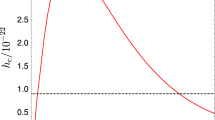
Overview
- Discusses the latest cutting-edge research in the field
- Focuses on the basic physics of each methodology
- Designed for the advanced undergraduate, 1st year graduate student studying dark matter
- This book is open access, which means that you have free and unlimited access
Buy print copy
Tax calculation will be finalised at checkout
About this book
A host of astrophysical measurements suggest that most of the matter in the Universe is an invisible, nonluminous substance that physicists call “dark matter.” Understanding the nature of dark matter is one of the greatest challenges of modern physics and is of paramount importance to our theories of cosmology and particle physics. This text explores one of the leading hypotheses to explain dark matter: that it consists of ultralight bosons forming an oscillating field that feebly interacts with light and matter. Many new experiments have emerged over the last decade to test this hypothesis, involving state-of-the-art microwave cavities, precision nuclear magnetic resonance (NMR) measurements, dark matter “radios,” and synchronized global networks of atomic clocks, magnetometers, and interferometers. The editors have gathered leading experts from around the world to present the theories motivating these searches, evidence about dark matter from astrophysics, and the diverse experimental techniques employed in searches for ultralight bosonic dark matter.
The text provides a comprehensive and accessible introduction to this blossoming field of research for advanced undergraduates, beginning graduate students, or anyone new to the field, with tutorials and solved problems in every chapter. The multifaceted nature of the research – combining ideas and methods from atomic, molecular, and optical physics, nuclear physics, condensed matter physics, electrical engineering, particle physics, astrophysics, and cosmology – makes this introductory approach attractive for beginning researchers as well as members of the broader scientific community.
This is an open access book.
Similar content being viewed by others
Keywords
Table of contents (11 chapters)
-
Front Matter
-
Back Matter
Editors and Affiliations
About the editors
Professor Derek F. Jackson Kimball’s research uses techniques of experimental atomic physics and nonlinear optics for precision tests of the fundamental laws of physics. In particular, his research focuses on searches for exotic spin-dependent interactions that may have a connection to dark matter or dark energy. Recent work focuses on development of levitated ferromagnetic torque sensors, devices that promise to greatly enhance sensitivity to spin-dependent interactions. He coordinates two international collaborations searching for ultralight bosonic dark matter fields: the Global Network of Optical Magnetometers for Exotic physics searches (GNOME) and the Cosmic Axion Spin Precession Experiment (CASPEr).
Prof. Jackson Kimball earned his Bachelor’s degree in Physics and Mathematics in 1998 and his Ph.D. in 2005, both at the University of California at Berkeley under the mentorship of Prof. Dmitry Budker, with whom he has collaborated throughout his career. In 2005,he joined the faculty of California State University – East Bay where he has mentored more than 70 undergraduate research students, and published three books and over 80 research papers. He was named Cal State East Bay’s Outstanding Professor in 2012, elected an APS fellow in 2018, received the 2019 Spitzer Distinguished Science Faculty Award, and awarded the 2022 APS Prize for a Faculty Member for Research in an Undergraduate Institution.
Professor Karl van Bibber received his BS and PhD from MIT in experimental nuclear physics. After postdoctoral work at LBNL, he served as an Assistant Professor of Physics at Stanford. He joined LLNL where he founded and led the High Energy Physics and Accelerator Technology Group, and was LLNL Project Leader for construction of the SLAC-LBNL-LLNL PEP-II B Factory project. His institutional service includes positions as Chief Scientist for the Physics and Space Technology directorate, and Deputy Director of the Laboratory Science and Technology Office. In 2009 he became Vice President and Dean of Research of the Naval Postgraduate School in Monterey, CA. In 2012 he joined the faculty of UC Berkeley as Professor and Chair of Nuclear Engineering, serving also as Executive Director of the Nuclear Science and Security Consortium, a DOE Office of Non-Proliferation center-of-excellence. In July 2017, he was appointed Associate Dean for Research in the College of Engineering. His research focuses on basic and applied nuclear science, particle astrophysics, and accelerator science and technology. He is the recipient of an Alfred P. Sloan Research Fellowship, the DOE Deputy Secretary Award for the SLAC-LBNL-LLNL PEP-II B Factory accelerator, and the Navy Superior Civilian Service Award for the establishment of degree and executive education programs in Energy, the first within the DoD. He is a fellow of the APS and AAAS. His research in particle astrophysics focuses on dark matter axion searches, and searches for the axion in general.
Bibliographic Information
Book Title: The Search for Ultralight Bosonic Dark Matter
Editors: Derek F. Jackson Kimball, Karl van Bibber
DOI: https://doi.org/10.1007/978-3-030-95852-7
Publisher: Springer Cham
eBook Packages: Physics and Astronomy, Physics and Astronomy (R0)
Copyright Information: The Editor(s) (if applicable) and The Author(s) 2023
Hardcover ISBN: 978-3-030-95851-0Published: 29 September 2022
Softcover ISBN: 978-3-030-95854-1Published: 29 September 2022
eBook ISBN: 978-3-030-95852-7Published: 28 September 2022
Edition Number: 1
Number of Pages: XX, 363
Number of Illustrations: 16 b/w illustrations, 62 illustrations in colour
Topics: Particle and Nuclear Physics, Astrophysics and Astroparticles, Cosmology



